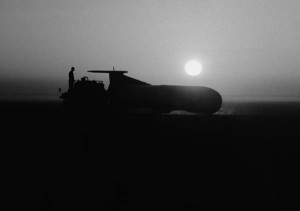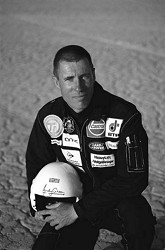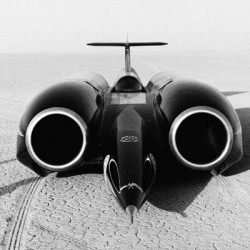

As the team towed ThrustSSC back to the inflatable Aireshelta that served as its base while on the Al Jafr desert, there were feelings of elation that Andy had hit 540mph - the fastest yet and very close to the ultimate goal for Jordan of 600mph - followed by mild concern when it was noticed that the back of the car seemed to be sitting slightly lower than normal. True Andy had reported some fishtailing when the chutes were deployed but that was a problem being gradually eliminated by experimentation with different parachute configurations and strop line lengths. That concern turned to disbelief when the back end was unbuttoned to reveal partly failed suspension mounting brackets and twisted suspension parts. It quickly became apparent that the very thing that made Jordan attractive in the first place - the hardness of the surface - had now brought this all important testing phase of the project to its conclusion. So the trip was a failure then? - not a bit of it! Here's why.
Immediately after the decision to conclude the Jordan testing trials after Run 33, aerodynamicist Ron Ayers was asked to sum up what had been achieved. Here's what he had to say: 'When we came out here, we had six major objectives to achieve:
With the sole exception of the speed objective (and we achieved 90% of that) all of the above objectives were achieved 100% in just 13 days. One more day of testing was probably all that was required to reach 600mph. In addition, the car exceeded its design performance and proved to be very stable, even on a variable and unsympathetic surface. As the speed increased so did the aerodynamic download - precisely as we predicted using the CFD analysis during the research phase of the project. Such accuracy is essential for safe operation in the transonic region. Last but not least, Andy Green proved to be an exceptionally good driver. His engineering assessments of all aspects of the car's performance has been of inestimable value to the Design Team. Sure it would have been nice to have exceeded the magic 600mph mark, but don't forget that we always said that the distance available - 10.2 miles - was always going to be marginal for those sorts of speeds. I have no doubts that the testing was was a success despite the problems at the end.
That's what Ron Ayers thought about the results, but how did the man in the hot seat view things? "I was really pleased with the performance of the car," said Andy Green, "especially with the way I was able to stop safely even with the damaged rear suspension. This proves the safety aspects designed into the car are working well. I am more confident than ever that with strengthened brackets, this car is capable of supersonic speeds on the smoother surface of the Black Rock desert in Nevada. Towards the end of the 540mph run as the car slowed first on parachute, then on the brakes as the parachute's effect lessened, I noticed that the steering was more difficult than usual. Not so much as to be overly concerned, but noticeable as I kept the car within 10 feet of the white line marking the course."

The man previously in the hot seat, Richard Noble, was fulsome in his praise of Andy's abilities with the world's most powerful car. "Andy's driving is very impressive. In 1983, I used to settle in the cockpit, fire up Thrust2 and settle back for one hell of a ride. Andy is completely and utterly different - he treats the cockpit as if it is his office. He is driving and working - 'Sorry about the slight drift to he right there, Richard, I was trying to shut down this and activate that and the red light kept winking at me, oh and we also had an FPress and WLock captions.' When we go through a debrief every aspect of the drive is gone through. Every aspect is checked with video and data and rechecked until it is thoroughly understood. While two six hundred mph drives used to exhaust me, Andy I am quite sure will be getting another head of steam and be redesigning the cockpit between runs. Car and driver seem well matched although he still doesn't like the rear wheel steering overmuch!"
The first indication of a problem came when the recovery team tried to jack up the rear end on its tow dolly to return SSC to the Aireshelta - the jack wouldn't fit underneath. Back at the Pit Station everything seemed well with the onboard video showing some good footage of the run, albeit with a couple of unfortunate failures. Then came the bad news that the rear suspension had been damaged during the run. As the car and the data logs were carefully examined the story unfolded and was summarised in one of Jerry Bliss' graphs showing suspension loads against distance. Everything was fine until the peak speed of 540mph when a bracket taking the load from the hydraulic ram on the leading rear wheel gave way. Effectively that wheel was no longer taking any of the car's weight. The active suspension's computers immediately compensated - fully extending the ram and taking all the load on the trailing rear wheel, and as Andy decelerated it held on for five seconds before the load cell between the ram and the hub gave way.
With nothing to take any load on the trailing rear wheel at all, it was simply along for the ride - a fact borne out by the tracks on the desert. The already damaged support bracket of the leading wheel took over the load as ThrustSSC slowed to a standstill.
So why did the bracket fail? Basically, it was fatigued by the constant battering it had taken over its two visits to Jafr, particularly the infamous and much repaired Bedouin track. While Black Rock averages around 9 on the California Bearing Ratio scale, Al Jafr is off the gauge. Throughout the design of ThrustSSC Glynne Bowsher has alway erred on the side of caution, but bear in mind that the car was designed for the much more user friendly surface of Black Rock. The battering of the higher speed runs and repeated blows as the car jumped over humps and troughs finally got the better of the fitting. The upside is that the frame of the car is completely unharmed, and the number of miles it achieved with the bracket collapsed amply demonstrates the inherent stability and failsafe design of the design. Detractors may question why it was necessary to subject the car to this treatment when a record was never a possibility given the length of the track, but that's missing the point. Worldwide searches produced Al Jafr as the only place where ThrustSSC could be tested at high speed at this time of year - testing that was vital before the trip to the Black Rock later in the year for the main event.
Everyone is fully aware of the incredible achievement of making nine runs in just thirteen days and getting close to meeting all the goals described at the beginning of this article by Ron. Jordan 2 produced an excellent result, but now it's time to focus on things in the UK so we can prepare for the biggest test yet - September's head to head against the Spirit of America team at Black Rock.



 |
 |
 |
||
| Sponsored by | This site best viewed with Microsoft Internet Explorer 3 | |||